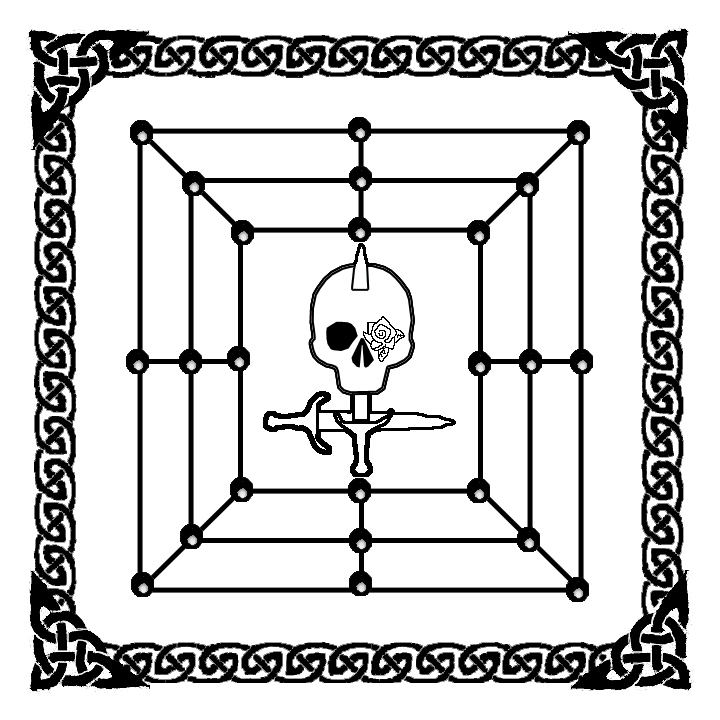Engraved and Stained Board with Smoothed Wooden Counters, based on works discovered from the mid to late 1500’s in the Germanic areas
Project Completed July, 2001 (images of completed project not found, though the design implemented is below.)

Rules
Setup
Each player should begin by choosing a color of counter. This may be done in several ways – flipping a coin, rolling dice, or simply by preference of color. The players should then take all counters of the color that they have chosen or won by chance. With white (or natural color counters in this case) going first, players alternate placing their counters on the circles of the board.
Beginning Play
Again starting with the white (or natural color) player, each player takes a turn moving a single counter along a line to an adjacent circle. Players may move either color counter until they have made 3 in an adjacent row that is marked by a line on the board. For example, 3 black counters along the outside line of the board, or 3 white (or natural) counters in a diagonal line in the corner of the board.
Ending Play
The game has been won when one player has been reduced to 2 of their color counters on the board, or is unable to move any pieces.
About This Project
Counters
The game pieces that are used in Nine Men’s Morris have been found made of antler, bone, stones and other mediums (regia.org). I have, for this version, created smoothed wooden counters. There are 9 black stained counters, and 9 naturally colored counters. I decided to work with wood since it would have been a readily available material at sea, due to the plentiful supply of barrels and the like on a ship. I used a wooden dowel, first sawing off small discs. I pulled away some areas of randomly chosen discs to make a more irregular shape along the discs, and then sanded the pieces down again to prevent splintering. The 9 natural color pieces were then stained with a clear sealant to bring the grain of the wood out better. The 9 black pieces were stained with a black paint to make them distinguishable from the natural ones.
The Board
Some of the Nine Men’s Morris boards that have been found in later period were extremely intricately carved. Examples from late period Germany even included carved ivory and mother of pearl like the reproduction on the left. Some of the intricate carvings in this piece are of “hunting and warfare” (Museum and Archive of Games). For my board, I have chosen a cross section of wood that a good friend had given to me quite some time ago. I engraved a knot work pattern along the outside of the board, and the emblem of my ship on the inside to keep with the theme of piracy. After engraving the board, I used black paint to fill the freshly engraved areas, quickly wiping away the excess paint with a damp cloth so that the paint did not settle outside of the engraved areas. I then also sealed the wood with a clear sealant to help bring back out the natural grain of the wood, and help protect it from accidental spills of beer, mead, ale, or rum (depending on what my crew is indulging in during the night times). The result was a slightly wood-burned look that I am rather pleased with.
Inspiration
I started playing Nine Men’s Morris shortly after I started playing in the SCA some years ago. I remember how much fun the game was then, and how much fun I still have when I play this game. I also remember making crude versions of the game with paint on a piece of leather. I had always wanted to make a nicer version of the game, one that would last longer than an aged (and well used) piece of leather.
When reading through books on the life of pirates, I came across a passage that said, “Pirates loved gambling and games as much as they loved their rum. Backgammon was a favorite of officers, but card games and dice were most popular among the average pirates.” (Kallen, p.45) I do not consider my persona to be that of an average pirate, so my persona would have probably been drawn to higher end games. It occurred to me that with the amount of people that were pillaged by pirates in the late period, the likelihood of running across a Morris board would be fair. As a result, I made the engraving of the Black Rose’s emblem in the middle of the board, thus marking it for the ship.
This project has served a few purposes for me. It has given me the nice board that I always wanted, and it has given me something more that my crew and I can do during events. I feel good that I have made this project, and hope to make other projects that are this fun again.